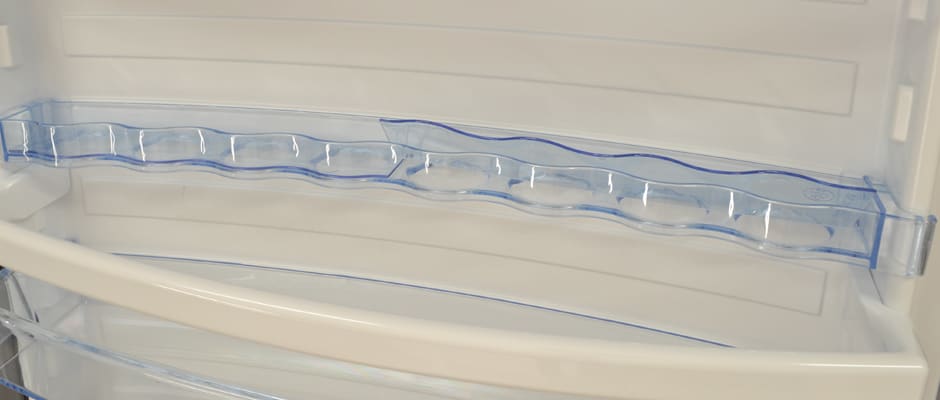Pros
Cons
Introduction
That being said, vague and complicated controls, in addition to lacking any sort of defrost cycle and being very energy inefficient keeps this product from being an ideal appliance. The extra vertical space—it measures 6 feet 7 inches tall—in addition to other positive attributes and features, makes the $1,400 MSRP very reasonable, but there are enough flaws in performance and usability to make you consider doing some comparison shopping.
Front
{{section_header}}{{section.name}}{{/section_header}}
Towering at over 6 feet high, the {{product.name}} has a stainless style exterior finish on the front. It can be bought in actual stainless steel, but will likely cost a few hundred dollars more. As its name implies, the taller fridge door is set on the top portion of the appliance with the smaller freezer door on the bottom. The finish isn't quite as shiny and reflective as other types of stainless steel, so make sure it won't clash with your other appliances before purchasing.
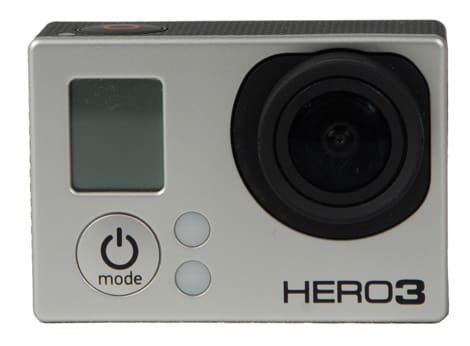
Despite being stainless steel, the smokey exterior finish is surprisingly resistant to fingerprints.

The control panel is found in a very unusual location. All the fridge's controls are located on the top of the fridge's door frame bracketing the interior light. It may be difficult for shorter individuals to reach since the fridge is so tall. The left side has a thermometer and a switch for a super freeze option. The right has two separate dials controlling the fridge and freezer temperatures.

The handles are set on the edge of the doors, and are very unusual for two reasons. First, they are almost comically tiny compared to the size of the door. Second, they fold over and overlap the front of the door. These two elements make for a look that's about as streamlined and unobtrusive as you can get without actually recessing the handles. Despite the miniature appearance, these handles are easy to use - they're not so small that your fingers can't fit or get a good grip, and it actually sits quite comfortably in your hand.

Interior
{{section_header}}{{section.name}}{{/section_header}}
The interior of the {{product.brand.name}}'s has a striking color scheme, combining traditional white walls with vibrant blue trim and blue plastic shelves. Despite its stylish interior and lots of extra detachable features, the inside of the fridge is actually quite spartan.
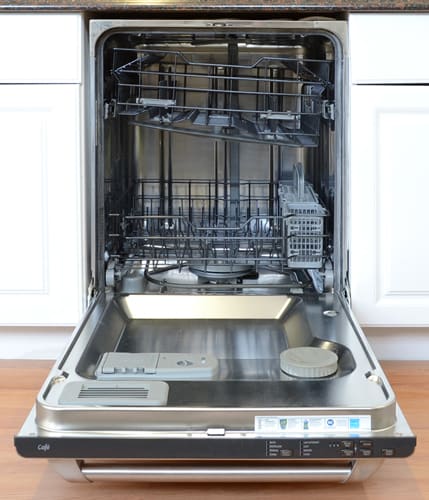
The interior of the CDWT980VSS.
The interior of the fridge has three flat, adjustable glass shelves. The bottom of the fridge has a fourth shelf which is can be moved, but isn't meant to be. The back of the shelf has a small ventilator built in to control the humidity level for the two matching drawers set below it.
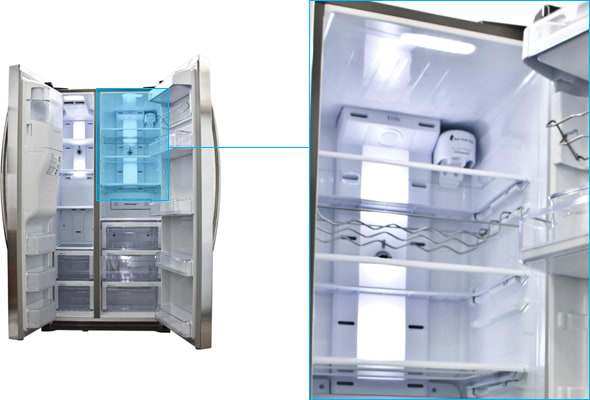
The fridge also comes with two removable features for the main fridge cavity. A beverage rack slides into one of the slots for shelf placement, and a second blue plastic container which just sits on a shelf. Uses for the beverage rack are pretty obvious.
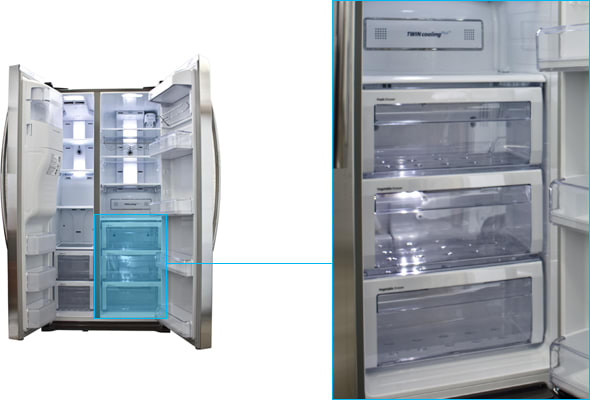
The ridged blue container was a bit more mysterious. Perhaps it's for loose item storage, perhaps a light-weight, easy-to-clean bin for storing defrosted meats so they don't spill on the shelves - your guess is as good as ours. There wasn't any mention of it on the manufacturer's website or in the user's manual.
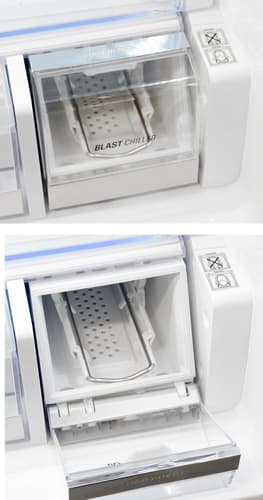
The crowning feature of this product is very easy to use and doesn't take up much room.
The {{product.brand.name}}'s fridge door has four adjustable shelves. Three of the shelves are meant to pair with a white front guard that holds in taller items. The guards are separate from the actual shelves, though, which are self-contained but have a fairly short front edge compared to other shelf models.
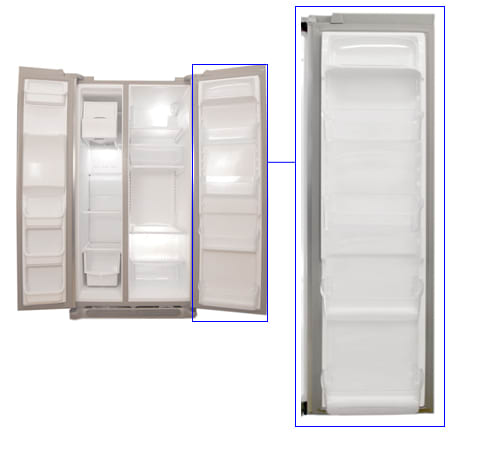
The fourth shelf (or any shelf, really, if you remove the front white guard), positioned on the top in our picture, is meant to house two uniquely shaped storage bins. Unlike more traditional dairy bins, these can be used for any sort of small item storage. They can be removed, stored on separate shelves, or kept together as they are in our photo. The lids are also unattached, just fitting into place when used. While they make for convenient, optional storage, reaching into the bucket from below can be as uncomfortable as removing them from the shelf entirely if you set them up too high.
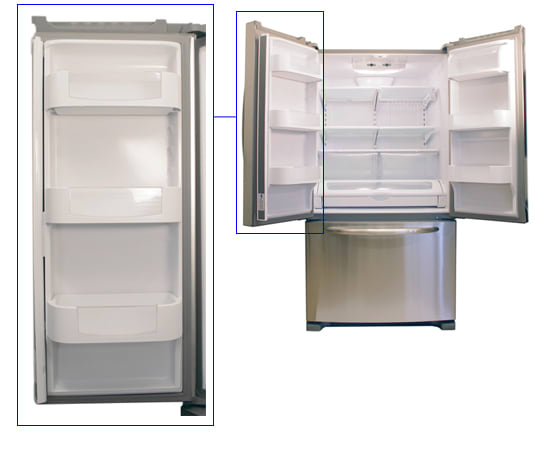
The fridge door also has a small egg shelf that slips into place just like the regular shelves. Shaped to allow loose eggs to be stored securely, the shelf also comes with two plastic covers that each block half of the holes. This allows you to block up some egg holes if you're not using them at the time, or to store other small items. Most unusually, though, is that the shelf only fits a maximum total of eight eggs at a time.

The freezer is divided up into three shelves. The top two are identical drawers that offer the bulk of the freezer's storage space and can be pulled out for easy food access. The bottom shelf is much smaller, and doesn't extend out all that far.
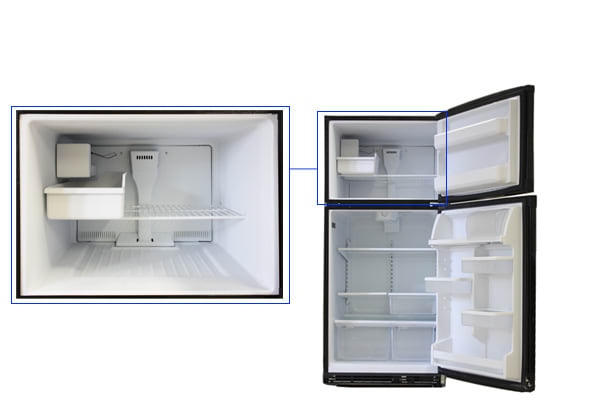
Above the three drawers is a small, pull-out tray designed to hold ice cube trays, three of which are provided with the appliance. In another odd spatial choice, only two of the provided ice cube trays can fit at a time.
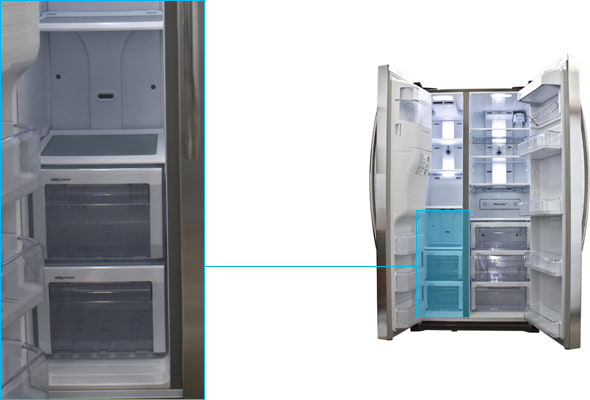
At the bottom, centered under the lowest drawer, is a spout that is opened to defrost the {{product.brand.name}}'s freezer. This process is discussed later on in our usability section.
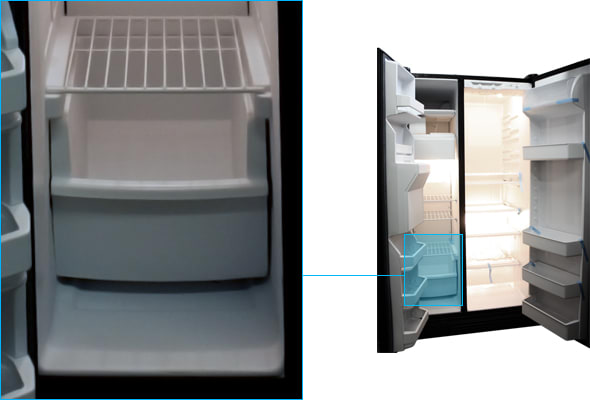
The freezer has no door storage. It's just an insulated door with a flat interior that keeps the cold air from getting out.
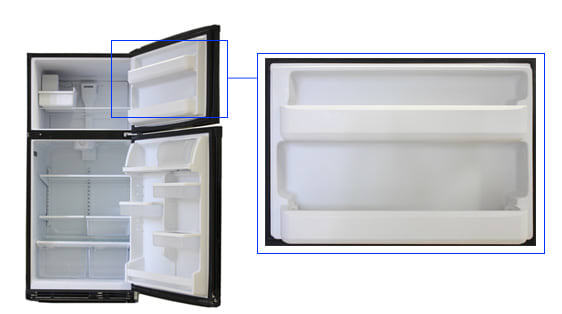
Back
{{section_header}}{{section.name}}{{/section_header}}
The back of the appliance is almost completely covered by a solid sheet of metal. The very bottom is left open, allowing for access to the working components of the fridge.
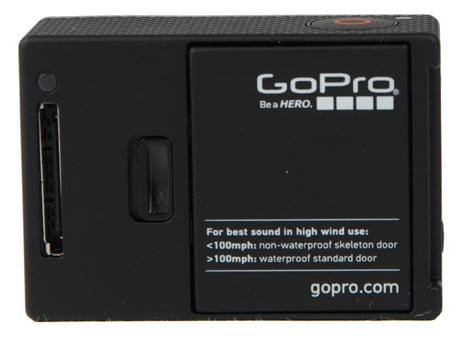
Sides
{{section_header}}{{section.name}}{{/section_header}}
Many models use a textured matte finish for the sides, but the {{product.brand.name}} has a solid gray design. This gives the whole product a higher-end, uniform appearance that matches on all visible sides.

Olympus SZ-31MR iHS side views
Running Cost
{{section_header}}{{section.name}}{{/section_header}}
We base all our power costs on a standard rate of $0.09 per kW-h. Using that figure, the {{product.name}} costs a whopping $59.23 per year. As a commercial fridge, it's exempt from Energy Star compliance, and it very much shows. This figure would be high for even a large family-sized fridge, but for a compact fridge like the {{product.brand.name}}, it's almost absurd. It may be due to the presence of the dual compressors, a typically high-end feature on larger fridges where a larger energy consumption rate is expected. Also, most modern fridges have a defrost cycle that causes the freezer to use slightly less power periodically, warming slightly to prevent the build-up of ice and frost. The lack of a defrost cycle in the {{product.brand.name}} means the freezer is always going full-throttle.
Power Use Per Cu Ft
{{section_header}}{{section.name}}{{/section_header}}
Such a high energy bill is indicative of inefficient power use. Per cubic foot of usable storage space, the {{product.name}} uses 0.23 kW-h. Really efficient fridges may use almost half that, making this model one of the worst choices we've reviewed for folks whose main focus is a low energy bill.
Fridge Temperature
{{section_header}}{{section.name}}{{/section_header}}
There was some confusion here as to what would be the ideal setting for the fridge interior. There's no manufacturer recommendation with regards to a specific setting, and 0 on the meter is actually the warmest option, not the coldest. The users guide doesn't help—it tells you what temperature to aim for, but offers no suggestion with regards to finding it other than trial and error with the thermostat. Without an external thermometer which you would have to purchase separately, there simply is no way to know how cold the fridge is.
The good news, however, is that temperatures remained very consistent over time, fluctuating at the most about one quarter of a degree, so once you've set your fridge, you don't have to worry about fiddling with it again. From top to bottom, though, things weren't quite as consistent. The principle of warm air rising was very apparent in the {{product.brand.name}}, as the very top of the fridge was substantially warmer than the rest by about four degrees. The middle of the fridge was perfect, however, so as long as you don't keep items that spoil easily near the top, you should be fine.
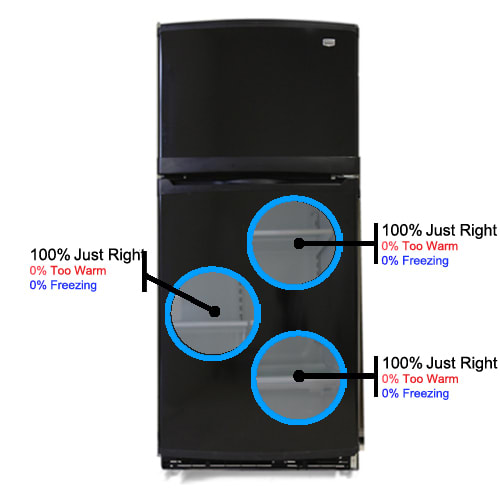
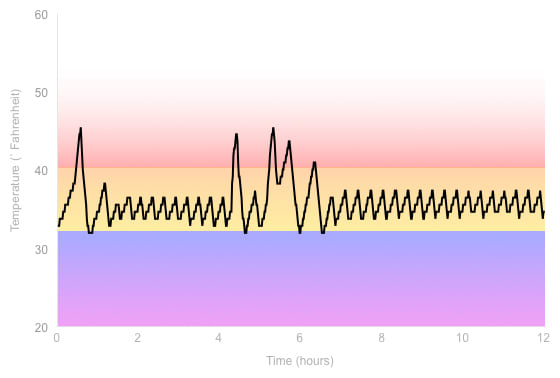
The {{product.name}} operates using a dual compressor system, meaning the internal temperatures of the fridge and freezer can be adjusted independently of each other. Given the ambiguous control layout, this is particularly beneficial - if one section turns out to be too warm or too cold, you can experiment with the settings without effecting the other section. Good news indeed, because based on our test results, you're definitely going to need to do some fiddling in order to find the right setting.
Freezer Temperature
{{section_header}}{{section.name}}{{/section_header}}
This fact is particularly useful for the freezer, whose temperature is actually measured using a thermometer located at the top of the fridge...albeit one in Celsius, so that may take some getting used to. The temperature in the freezer overall remained consistent over time, fluctuating less than half a degree. This was somewhat expected, given that the lack of a defrost cycle means nothing's going on at night that would cause the temperature to fluctuate. However, even though the freezer is quite small, there was a noticeable difference in temperatures from the top of the compartment to the bottom. While the top was more or less spot on, keeping things near the ideal 0 degrees Fahrenheit, the bottom of the fridge was almost three degrees colder. While lower temperatures don't necessarily hurt your food as long as they remain consistent, the small size of the compartment makes it important to note that the {{product.brand.name}} isn't delivering equally cooled air throughout the whole section.
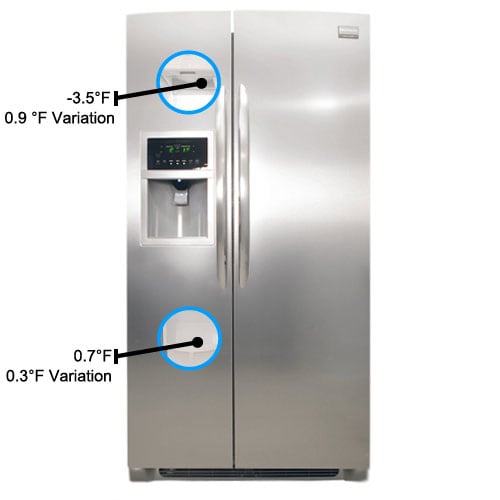
Vegetable Drawer
{{section_header}}{{section.name}}{{/section_header}}
The vegetable drawers on the {{product.brand.name}} give off a very mixed first impression. They're durable and easily accessible, but they have no track and can flop around when you move them. To top it off, the humidity "control" consists of a vent that be pushed ever so slightly at the back of the drawer, a method that looks decidedly suspect. But to our surprise, these drawers actually did quite well. Over time, they exhibited a rate of moisture loss that totaled just 0.15 grams per hour. This surpasses even some of the fancier-looking, smoother drawers, proving that the appearance or feel of an appliance doesn't always reflect its performance quality.
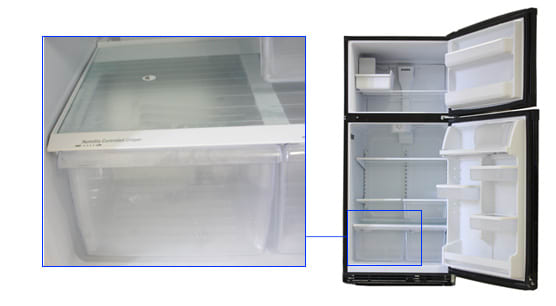
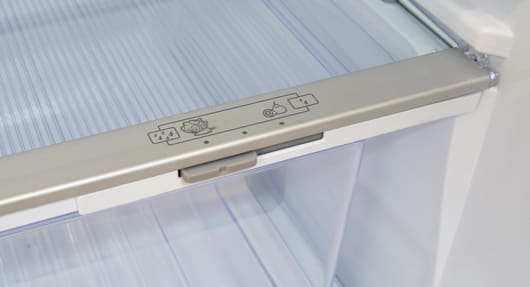
Power Loss
{{section_header}}{{section.name}}{{/section_header}}
Despite its small size, the {{product.brand.name}} managed to prevent frozen items from thawing out for more than 36 hours after we cut the power.
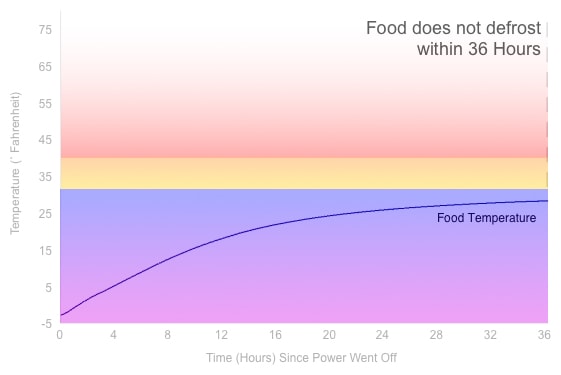
Freezing Performance
{{section_header}}{{section.name}}{{/section_header}}
You might think that the small size of the {{product.brand.name}}'s freezer would mean cold air, having to cover less area, would cause items to freeze very quickly. This wasn't exactly the case - it took 1 hour and 28 minutes for our room-temperature items to become frozen. This isn't terrible - many fridges, regardless of size, end up taking this long to freeze items - but compared to other appliances that we've reviewed, it's far from the best performance available.
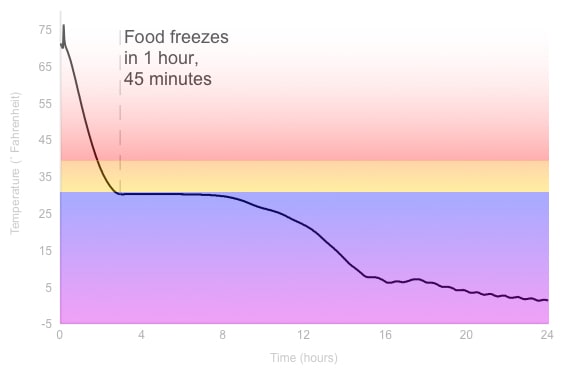
Usable Space
{{section_header}}{{section.name}}{{/section_header}}
When advertising storage space, manufacturers measure the entire interior space. We, however, subtract the space taken up by shelves, light fixtures, and any other feature that blocks food storage. The {{product.name}}, though, has quite a few extra features that can be used or not depending on your refrigeration needs which aren't typically found in other models. As such, our totals still take into account shelf space, but we decided to ignore both the beverage rack since it's such a specialized feature, as well as the blue storage box since it's so easily removable. That said, we found the {{product.brand.name}} had a total of 5.36 cubic feet of usable storage space.
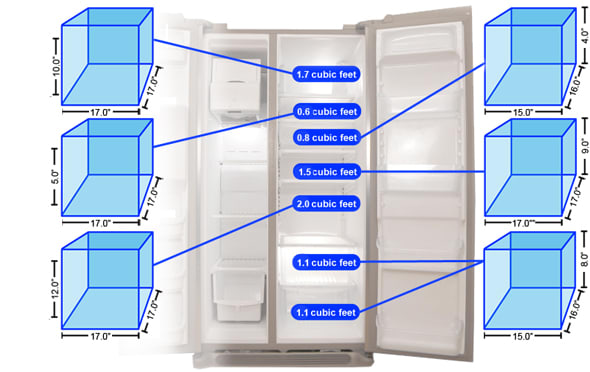
The fridge door offers storage space spread out over four shelves. Like the beverage rack and storage block in the main section, we opted to ignore the egg rack in our storage calculation since it's such a specialized optional feature. However, in the spirit of a more traditional dairy tray, we did include the two removable buckets at the top, subtracting the small amount of extra space that they took up from the usable storage space total.
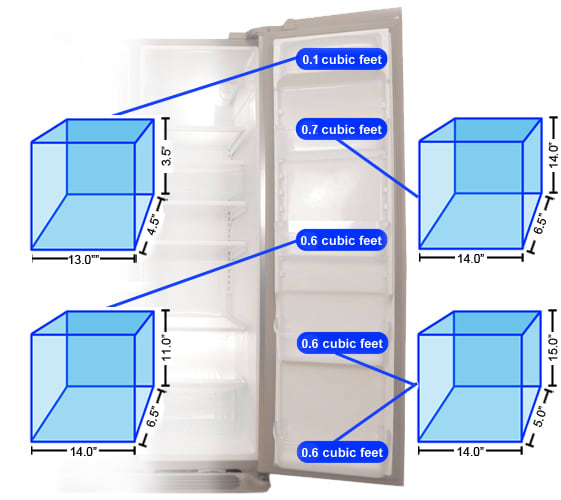
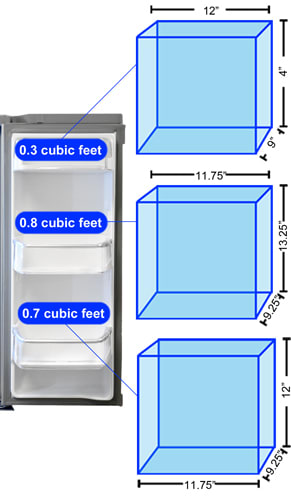
The freezer only has 2.3 cubic feet of storage space. The bulk of the space is found in the top two drawers.The bottom drawer is much smaller, limited storage options. None of the drawers are particularly tall or bulky, meaning oddly shaped or very large items may be difficult to store. The tray at the top was clearly meant to store ice cube trays, but folks that don't want or need to use them may be able to keep thin items like certain frozen dinners or ice packs in there instead.
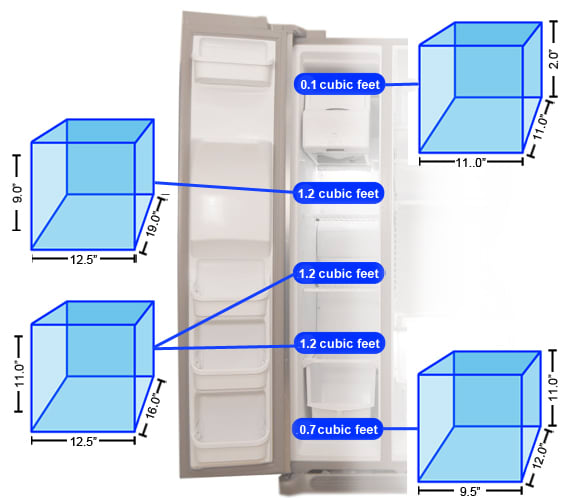
The freezer door just serves as a fourth wall of insulation. No shelves mean no storage.
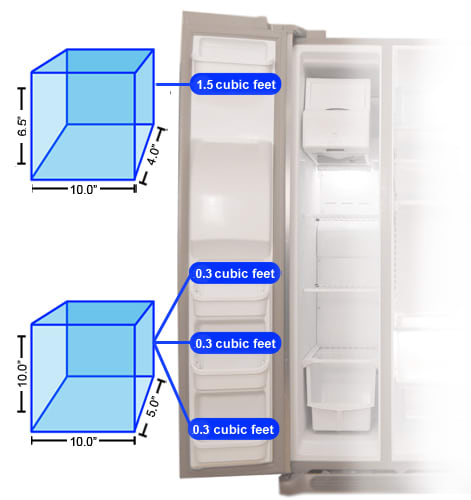
Below are the manufacturers own figures for capacity, and our own measurements for usable capacity. The manufacturers figures do not take account of the shelves, drawers and other removable features, but our measurements do account for the space these take up.
Ease of Access
{{section_header}}{{section.name}}{{/section_header}}
The height of the {{product.name}} may be a hindrance to some consumers. Food placed at the top of the fridge, either in the main section or on the door, may be difficult to remove easily. Otherwise, the short depth of the fridge and the amount of space between shelves mean every other part is easy to access. The freezer is a bit of a mixed bag as far as getting to your food. The top two drawers pull out fairly far, making it easy to get to most frozen items. The smaller bottom drawer, on the other hand, hardly comes out at all - you pretty much have to remove the entire drawer to get anything in or out.
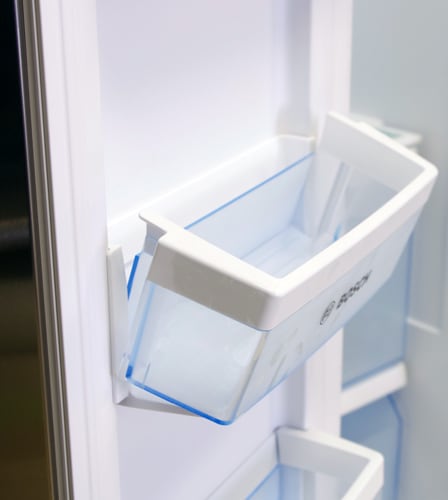
Controls
{{section_header}}{{section.name}}{{/section_header}}
The control panel is found in a very unusual location. All the fridge's controls are located on the top of the fridge's door frame bracketing the interior light. It may be difficult for shorter individuals to reach since the fridge is so tall. The left side has a thermometer and a switch for a super freeze option. The right has two separate dials controlling the fridge and freezer temperatures.
The controls are placed in a relatively traditional spot, but the {{product.brand.name}}'s height means that this usual location is unusually inconvenient. Placed at the top of the fridge frame, the controls can be very hard to reach for shorter individuals. It doesn't help, either, that they were designed with labels that are so small as to be just barely legible. And good luck if you lose the manual - the symbols for the Super Freeze function on the left, used to defrost the freezer, are just labeled with letters that don't indicate at all what they do.

The temperature controls for the two compartments aren't adjusted with knobs; rather, the dial has an indentation that looks like the head of a screw which you have to pry in one direction or the other to adjust. Finally, the thermometer only applies to the freezer. There is no recommended manufacturer setting for the knobs, either. This means the fridge is essentially trial and error, with no way of knowing what temperature you're storing your food at. If you don't own a thermometer to gauge what's going on inside your fridge, you're out of luck. Thankfully, the user's manual does at least tell you what temperature to shoot for, so you won't be flying completely blind. Be warned, though - the manual isn't an a truly devoted guide. It states that 0 and 7 are the Min and Max temperature settings, respectively. Counter-intuitive though it may seem, Min doesn't mean Minimum Temperature - it means Minimum Cooling, with 0 as the warmest setting.
Water Dispenser
{{section_header}}{{section.name}}{{/section_header}}
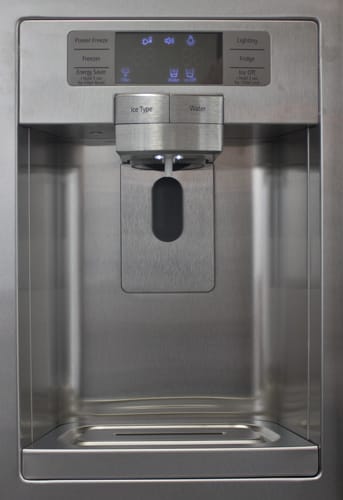
Ice Maker
{{section_header}}{{section.name}}{{/section_header}}
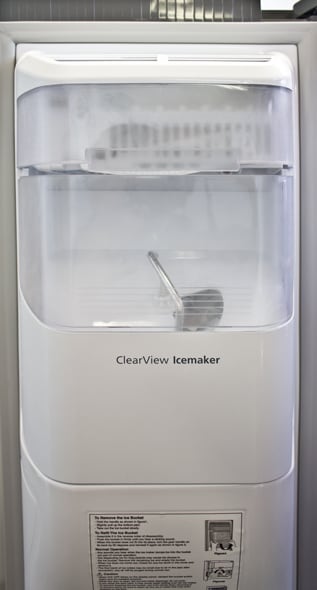
Cleaning
Noise
Other Features
{{section_header}}{{section.name}}{{/section_header}}
Unlike most modern fridges, the {{product.name}} has no internal defrost cycle. This means that, over time, frost and ice may build up inside the freezer, making it less energy efficient. Instructions are found in the user's manual as to how to deal with this using the Super Freeze function controlled by the switch located to the left of the fridge's light bulb. It's a hassle, but the spout located at the bottom of the freezer makes it a bit easier to deal with than more traditional hacking at built-up ice off the freezer walls using a screwdriver. The manual provides more detailed instructions, but once the frost in the freezer has melted, it will drain out the spout into a bowl of your choice, at which point you can just pour it down the sink.
{{product.manufacturer_specs['Other Features Photo BROKEN?']}}
Conclusion
Energy Efficiency
Possibly the largest failing on this small fridge, the energy consumption is larger than fridges more than twice the size of the {{product.name}}. With a yearly energy bill that matches some family-sized fridges and an energy efficiency rating that would make Al Gore assume the fetal position and weep, this is not the appliance for folks trying to get the biggest bang for their buck with respect to electricity.
Performance
The greatest issue with performance found on the {{product.brand.name}} wasn't a result of testing or quality, but rather of the controls. The vegetable drawers retained an impressive amount of moisture, the freezer remained cold while keeping the risk of freezer burn low, and the fridge kept temperatures consistent and over time. There were some issues with fridge temperature from top to bottom, with the highest points running substantially warmer than the rest of it. If you can figure out the perfect control setting, you'll have a very dependable fridge, albeit one where your soft cheeses would be better off staying near the bottom.
Storage Space
The clever use of vertical space in the {{product.name}} does mean that you get a bit more capacity in the fridge compartment than you would inside other compacts. When you get down to basics, though, this is still a small fridge. Unless a consumer has a rather unusual design aesthetic, these types of fridges should really only be sought out for kitchens with limited space. If you have a narrow kitchen with high ceilings, this appliance could be a perfect fit.
Usability
The shelves are easy to remove and fridge storage is easily accessible, but that's all we can say that's complementary. Temperature controls are hard to both read and use, spill protection in the main portion of the fridge is painfully inadequate, and there's no automatic freezer defrost. The {{product.name}} may be a compact fridge, but it actually turned out to have more usability issues than a lot of full-size modern fridges.
Meet the tester
Matthew is a native of Brockton, Mass., and a graduate of Northeastern University, where he earned a degree in English and Theatre. He has also studied at the Gaiety School of Acting in Dublin, Ireland, and spends time pursuing a performance career in the greater Boston and Cambridge area.
Checking our work.
Our team is here to help you buy the best stuff and love what you own. Our writers, editors, and experts obsess over the products we cover to make sure you're confident and satisfied. Have a different opinion about something we recommend? Email us and we'll compare notes.
Shoot us an email